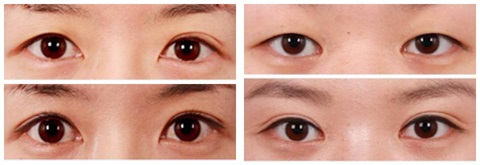
1. Eyelid Surgery: There are two common methods for eyelid surgery; one is creating a clear eyelid crease by removing sagging skin, muscle, fat layer on the eyelid through the incision, and the other is making a series of small holes on the eyelid for a continuous buried-suture to pass through to create the crease. Existing simple buried-suture method only made a few knots which rather had higher probability for the knots to be undone. Continuous Single knot buried-suture method firmly integrates skin and fascia on the entire length of an eyelid crease, thus, resulting in clearer and natural looking eyelid crease without getting undone.
2. Ptosis Surgery: Weak levator palpebrae superioris muscle causes droopy eyelids which covers part of pupils and makes one’s eyes to look smaller. Shortening vertical length of levator muscle exposed through the incision can make the eyes to be opened wider.
3. Upper Blepharoplasty: Excise sagging skin above eyelash to create younger looking eyes.
4. Under Eyebrows Resection: Excise thicker skin below eyelashes to reveal sagged and covered eyelid crease and diminish fine wrinkles around the eyes. Surgical scars are barely noticeable.
5. Lower Blepharoplasty: Under eye wrinkles removal. Excise sagging muscle and skin parallel to eyelashes right below the lash line for those have thinner skin with no fat. Fatty bulges underneath the eyes can also be corrected through lower blepharoplasty.
6. Conjunctival Eye Bag Surgery: The incision is made through the inner side of the eyelid to eliminate eye bag if you don’t have many fine lines under eyes with good skin elasticity. Conjunctival eye bag surgery doesn’t leave much bruise or swelling.
7. Epicanthoplasty: Epicanthal fold removal surgery is done to create more prominent upper eyelid crease. Compared to existing epicanthoplasty that often leaves visible post-surgical scar line, new surgical method effectively eliminate epicanthal fold without the scarring by separating and removing the excess skin of upper eyelid through minimal incision and relieving adhesion of the skin of lower eyelid and canthus ligament.
8. Lateral Canthoplasty: Lateral canthoplasty is performed to create a wider eye by lengthening the outer part of the eye through an incision, and also to adjust the angle of Mongolian slant.